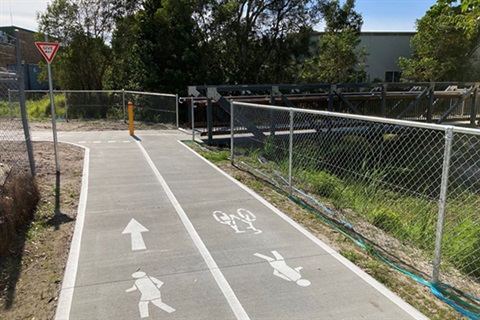
New shared pedestrian and cycle pathways have opened in the Byron Arts and Industry (A&I) estate as part of Council’s Additional Flow Path project.
In a collaboration between Council and Arakwal the drainage upgrade project brings better access to local businesses, greener spaces for the community and improved water management in the Belongil catchment.
Byron Shire Council’s Project Manager for Utilities, Josh Winter, said the additional flow path is designed to channel excess treated water from the Byron sewage treatment plant (STP) during dry weather, which previously went west through farmland before entering the Belongil Creek.
“We now have two pathways instead of one to manage treated water from the STP and stormwater flows across the catchment,” Mr Winter said.
Stretching over 2.3km, the additional flow path extends from the Byron Bay STP, diagonally south-east across the Byron A&I Estate and continues to Ewingsdale Road.
It rejoins the Central Drain at the southern end of Belongil Creek.
Approximately 700 metres of new shared pathway and cycleway and a 14-metre long fiberglass pedestrian bridge have been built alongside the drainage route.
The additional flow path aligns with the Byron A&I Estate Precinct Plan and the landscaping works are being delivered in tandem with a new pocket park, on the corner of Bayshore Drive and Banksia Street.
“This project brings benefits for cyclists, pedestrians, residents and businesses, as well as improving water quality entering the Belongil estuary,” Josh said.
Water sensitive urban design has been incorporated with more than 4,500 native species being planted by Arakwal members.
The plants will help stabilise drainage batters and improve the quality of water (through a reduction in nutrient concentrations) before it enters the Belongil Creek.
Bundjalung of Byron Bay Aboriginal Corporation RNTBC (Arakwal) General Manager, Ross Tregidga, said the project was an important opportunity for hands-on involvement in the management of the Belongil estuary, a place that has great cultural significance for the Arakwal people.
“These plants will provide food for native animals and birds and help improve stormwater quality with highly treated water before it enters the Belongil Creek, which is beneficial for the land, water and people,” Mr Tregidga said.







